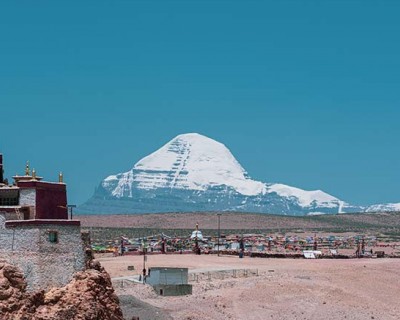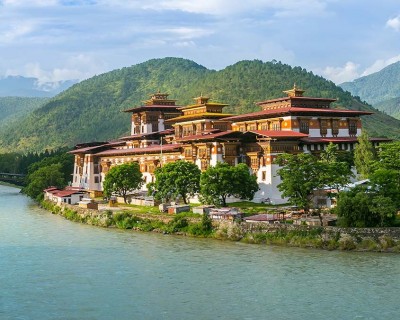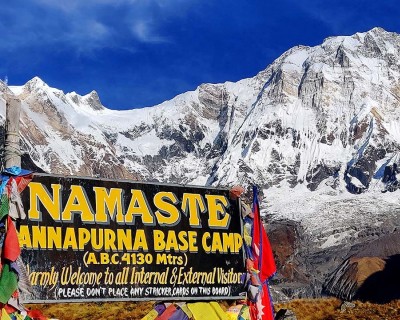Mount Everest (8,848.86m) and Mount Kanchenjunga (8,586m) are two of the most iconic peaks in the Nepali Himalayas. Ranked number one and two among the grandest Himalayan peaks in Nepal, the basin of both of these glorious peaks are top trekking destinations. If you are considering these incredible trekking prospects and curious about which might be the most appropriate route for you, welcome to Kanchenjunga Vs. Everest Base Camp discussion.
In this piece of article, we will discuss all the major aspects related to this exhilarating mountain journey. From the general trek overview, highlights, and difficulty level to cultural/natural experience, coast and best time for each trek, we will discuss everything to help you make up your mind about your next big Himalayan adventure.
Trek Overview
Kanchenjunga Trek
Location: Far East Nepal, Taplejung
Duration: 18 to 26 days
Total Trekking Distance: 220 km (136 miles)
Difficulty Grade: Moderate to challenging
Highest Elevation Point: Kanchenjunga North Base Camp/ Pang Pema (5,143m/ 16,873ft)
.jpg)
Unlike the mainstream trekking destination, the far-eastern Kanchenjunga region is more renowned for the off-beaten trekking experience. Given that the duration of Kanchenjunga trek is slightly longer compared to other major trekking routes, the experience certainly is unparalleled.
The trekking route of this tranquil journey navigated the most isolated part of the Himalayas that are secluded from the modern life hustle and bustle. Thus, your trekking experience on this off-beaten route will really feel like an authentic Himalayan experience where you embrace the raw beauty of the Himalayas.
Traversing across the ancient high-altitude settlements, you will then head toward the gigantic third-highest mountain in the world, Kanchenjunga. The incredible biodiversity of the Kanchenjunga Conservation Area is also one of the major highlights of this wilderness exploration.
Everest Base Camp Trek
Location: Eastern Nepal, Solukhumbu
Duration: 10 to 15 days
Total Trekking Distance: 130km (80 miles)
Difficulty Grade: Moderate
Highest Elevation Point: Kala Patthar (5,644m/ 18,517ft)
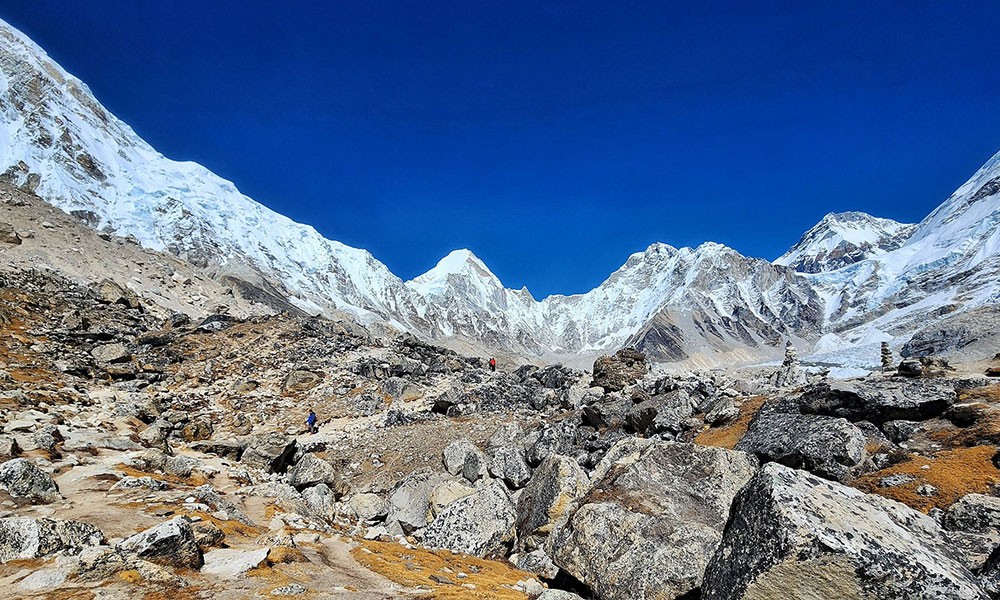
Everest Base Camp Trek is the most renowned base camp exploration in the world. This thrilling route takes you across the major highlight of the Khumbu region and to the basin of the highest snow-clad peak in the world is a remarkable and memorable experience.
During this trekking journey, you will get a chance to explore the popular Sherpa settlements spread across the region, as well as their lifestyle, unique culture and traditions. Also, the rare flora and fauna of the UNESCO Heritage Site, Sagarmatha National Park, will be a thrilling experience.
In overall, if you are looking for a top-tier Himalayan trekking journey that provides a complete Himalayan trekking experience, this is an ideal option for you. The trek won’t feel on any aspect and you will also get a chance to admire the stunning towering peaks of the eastern Himalayan region.
Highlights of Both Treks- Kanchenjunga Vs. Everest Base Camp
Before moving further in this Kanchenjunga Vs. Everest Base Camp discussion, let’s check out the major highlights each of these trekking routes offers.
Kanchenjunga Trek Highlights
- A magnificent journey in solitude away from the crowd of mainstream routes
- Remote and unspoiled wilderness of the Himalayas
- Opportunity to explore Rai, Limbu, Thakali, Gurung, Sherpa, Jirel, and Tamang settlements
- Traverse to the base of the third highest mountain in the world, Kanchenjunga
- A long-duration mountain journey to take a break from the remote hassle of the modern lifestyle
Everest Base Camp Highlights
- Reaching the base of Mount Everest, the tallest mountain of the world
- A thrilling journey to the heart of the Himalays
- Iconic mountain views of beautiful peaks such as Everest, Nuptse, Lhotse, Ama Dablam, Changtse, Cho Oyu and many more
- Beautiful Sherpa culture and the opportunity to relish its beauty
- Exploring Kala Patthar (5,644m), the highest viewpoint in the region
Accessibility
Kanchenjunga Trek
As the Kanchenjunga Trek is a thrilling journey of the remote part of the Himalayas, you will get the opportunity to admire the raw and unspoiled factors of the wilderness. However, you will also need to prepare for the remoteness factor of the trip as you have to cope with limited resources.
Although the level of services and amenities in this trek is not on par with mainstream destinations, they are still on a moderate level and comfortable. As for the fasciitis along the trail, they are in a limited number due to extreme remoteness.
To reach the starting point of this trek, Sekathum (1,575m), you will have to first take a flight from Kathmandu (1,400m) to Bhadrapur (91m). Then, drive across Phidim (700m) and Taplejung (1,820m), which will finally take you to the trek starting point.
If you are looking for an ultimate destination that provides you the opportunity to explore the unspoiled beauty Himalayas away from the large number of trekking groups, this is the most suitable option for you.
Everest Base Camp
Compared to the Kanchenjunga Trek, the Everest Base Camp Trek takes place in a mainstream region. Everest region is generally famous for the most exciting Himalayan trekking and mountain expeditions. Thus, this mainstream trekking destination has been developed to accommodate the needs of a large scale of travelers from all around the world.
You will be able to enjoy standard to luxurious levels of services and amenities while doing the Everest Base Camp Trek. The starting point of this trek, Lukla (2,800m), is also easily accessible by flight. There are a sufficient number of teahouses along the trail and the medical facilities in these regions also provide comprehensive services.
So, on this exciting mainstream trail, you will be able to enjoy a comfortable journey without missing out on any Himalayan experience. This major route of Nepal is a blend of thrilling Himalayan exploration amidst iconic peaks, an immersive Sherpa cultural experience and a gratifying journey with a sense of achievement conquering the highest part of the trails in the Everest region.
Note: If you want to explore the traditional route for this iconic trek, you can take Salleri to Everest Base Camp Trek package, which follows the driving route.
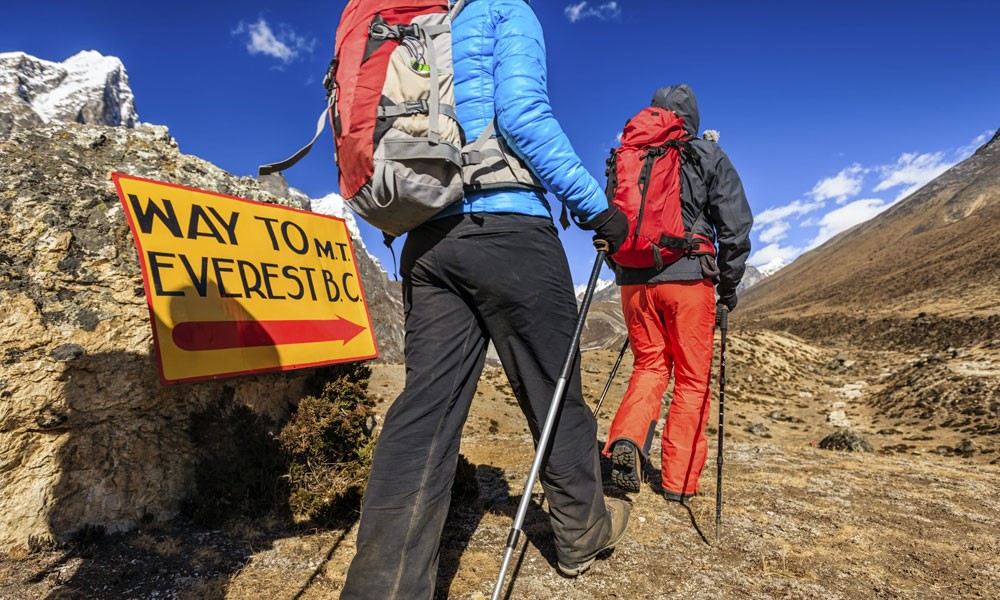
Physical and Mental Challenges
Kanchenjunga Trek is one of the longest endeavors in the Himalayas. As this trek has a duration of 18 to 26 days, the overall length can be a challenges aspect of this off-beaten. From a grading point perspective, the difficulty level of Kanchenjunga Trek is just at a moderate to challenging level.
This beautiful off-beaten trekking experience is a long exploration option in the Himalayas. Even if the overall altitude gain is not that significant in this trek, its remoteness, lack of infrastructure and modern amenities can be challenging factors.
That’s why this trek is not generally recommended for new trekkers who don’t have any prior high-altitude remote region exploration experience. Similarly, the overall trekking distance of the Kanchenjunga Trek is about 170 to 220 km (105 to 136 miles).
Also, you will need to push for the maximum altitude in this trail, which is at Kanchenjunga North Base Camp (5,065m) and the overall altitude gain is about 3,245m (10,646ft) from the starting point. Thus, due to the high altitude nature of the trek and the long hours of trekking duration, trekkers need to have a good level of fitness.
Everest Base Camp Trek is the most popular trekking adventure in Nepal. This trekking endeavor in the eastern Himalayas is not just popular because of the iconic highlights but due to the moderate difficulty scale of the journey as well.
The unparalleled exploration of the most iconic peaks in the Himalayas, moderately difficult trails, immense cultural exposure, and phenomenal natural beauty make this Himalayan route one of the most beloved adventures in the country.
During this Himalayan adventure, you will walk a trekking distance of 130km (80 miles). Similarly, the altitude gain of the entire trip, from the starting point, Lukla (2,800m) to the highest point, Kala Patthar (5,644m), is about 2,844m (9,330ft)
Even if you have to push for a significant altitude in this trek, you will have enough time to acclimatize properly to the rising altitudes. Similarly, the trekking distance in each day’s trek is not that significant.
You will also won’t have to deal with the complete isolation factor in this Himalayan journey as the Everest region is one well-developed mainstream trekking region that can easily cater to the needs of travelers.
Wildlife and Nature
Kanchenjunga Trek
During this exploration of the far-eastern part of the Himalayas, you will have the opportunity to traverse across the Kanchenjunga Conservation Area (2,035 sq. km.). This protected area in the isolated part of the Himalayas is home to exotic Himalayan flora and fauna.
This Himalayan conservation area comprises of rivers, lush woodlands, wide pastures and glaciers. There are over 2,000 species of flower plants in this conservation area and 23 of those species are endemic to Nepal.
Similarly, there are more than 252 species of birds, 22 species of mammals, 5 species of fish a, 6 species of amphibians and 82 species of insects in this conservation area. Thus, this off-beaten tranquil trail in the Himalayas will introduce you to some of most fascinating and eloped flora and fauna.
Everest Base Camp Trek
Like Kanchenjunga Trek, Everest Base Camp Trek will also take you across major protected areas in the Himalayas. While following the mainstream trails in this trek, you will have the chance to explore the World UNESCO Natural Site, Sagarmatha National Park (1,148 sq. km.).
After its establishment in 1976, this park was listed as a UNESCO Natural Site in 1979 and in 2002, a 275 sq. km. of buffer zone was added to the park. This national park is spread across multiple climatic zones. Upto 4,000 meters, there are lush forests, rivers, and waterfalls. As you move higher that point, then wide grassland, dwarf shrubs and cushion plants take over the landscape upto 6,000 meters.
Sagarmatha National park has 118 species of birds and exotic wildlife, such as red panda, musk deer, Himalayan tahr, musk deer, snow leopard, etc. During your exploration, you will have the chance to explore the endangered species of flora and fauna that are only natives to this region.
Cultural Experience
Kanchenjunga Trek
Kanchenjunga Trek covers a significant portion of the far-eastern Himalayan region. Thus, during this trek, you will have the opportunity to explore a diverse range of ethnic communities that are natives of the Himalayan region.
Thanks to the isolation of this beautiful Himalayan region from the rest of the world, the cultural experience here is very authentic. You will have the chance to admire the true handed-down and authentic culture, tradition and lifestyle of the natives who have truly embraced the Himalayan lifestyle.
The major ethnic groups in the Kanchenjunga region are Rai, Limbu, Thakali, Gurung, Sherpa, Jirel, and Tamang. That means you will have the chance to explore a wide range of ethnic communities in a single trip.
Everest Base Camp
Compared to the incredible cultural diversity of the Kanchenjunga Trek, the route of the Everest Base Camp Trek generally moves across the major Sherpa settlements. Everest region is popular as the home of the indigenous Sherpa people, who are also known as conquerers of mountain peaks.
So, in this well-established route, you will have the chance to admire and explore the beautiful Sherpa culture, norms, and lifestyle. As the settlements in this mainstream route have adapted to the modern living style in order to cater to the needs of travelers from all over the world, the cultural experience on this route may not feel that authentic.
However, you will still get a chance to admire the most popular Sherpa settlements of the world and move along the spiritual trails which have traces of the beautiful Buddhist culture.
.jpg)
Cost Comparison
Kanchenjunga Trek
The cost of Kanchenjunga Trek is generally higher due to the longer itinerary days and logistics in the remote region. The general cost margin for the standard Kanchenjunga Trek package is around US$ 1,700 to US$ 2,500.
Pricing of the package will be reliant on the overall duration of the trip, exploration of side highlights, route taken and quality of services/amenities. If you want to take an even more extensive route, i.e., Kanchenjunga Circuit Trek, the cost of the package can be even higher.
The price for the circuit trekking experience in this off-beaten route can range somewhere between US$ 2,000 to US$ 4,000. Due to the requirement of a long trekking period, the journey on the circuit route can last almost upto a month. That’s why it is both an extensive and expensive way to embrace the tranquil beauty of isolated far-eastern Himalayas.
Everest Base Camp
Compared to the long exploration route of the Kanchenjunga Trek, the cost of the Everest Base Camp Trek is on a more budget-friendly scale. Depending on the experience you are looking for, you can choose the most appropriate package for you.
The cost of the standard 12 Days Everest Base Camp Trek is around US$ 1,300 to US$ 1,600. For the same trekking route option, you can also enjoy Luxury Everest Base Camp Trek, which costs US$ 2,550 with Marvel Adventure.
Similarly, if you are looking for a budget-friendly adventure package, 11 Days Budget Everest Base Camp Trek costs only US$ 1,099 per person. So, for the Everest Base Camp Trek you can select the best value package that is ideal for your exploration.
Best Time to Trek
For trekking in Nepal, the most preferred seasons are spring (March to May) and autumn (September to November). However, it is not like that trekking is not possible during other seasons. You will be able to secure an incredible experience during these peak months in both of these routes.
But, when it comes to other season adventures, Kanchenjunga Trek is not generally recommended during the monsoon and winter seasons. Due to extreme isolation, challenging trails and varying climatic factors, trekking on this route during the off-seasons can be quite a bit of a challenge.
Under both rain and heavy snow, you will need to traverse a long distance. As for the Everest Base Camp Trek, it is not that popular during the monsoon season due to the continuous downpour and cloudy view.
However, during the winter, it is possible to take on this mainstream route even if the trail will pose some challenges. It will be upto you and what kind of experience you are looking to select the appropriate period for your journey.
Kanchenjunga Vs. Everest Base Camp: Which Trek is Right for You?
After exploring so many factors about Kanchenjunga Vs. Everest Base Camp trek experiences, it's time to draw the conclusion on the most suitable adventure for you. Kanchenjunga Trek is suitable for those trekking enthusiasts who are seeking off-beaten experience in the Himalayas.
This far-eastern exploration is suitable for trekkers who want to explore the raw and unspoiled Himalayan wilderness and don’t find the physically demanding and remoteness factor of the trip. As for the Everest Base Camp Trek, it introduces you to the foothills of the heart of the Himalayas.
You will be able to take on your Himalayan journey following a comfortable, well-established route. The available facilities in this region are from standard to premium levels. So, if you want to enjoy an iconic experience that has a standard duration and you don’t need to steer off far from the modern-lifestyle, this trip is an ideal Himalayan experience.
.jpg)




.jpg)
